from the October 2, 2016 Newsletter issued from Rancho Regensis north of Valladolid, Yucatán, MÉXICO;
elevation ~40m (~130 ft), N~20.876°, W~88.170°
EATING SARAMUYO
The genus Annona embraces several species producing sweet, big-seeded fruits about the size of a baseball and often found growing around people's homes in tropical America. Among the English names used for the species are Custard-apple, Soursop, Sweetsop, Guanabana, Cherimoya, and Sugar-apple.
Around here the Sweetsop or Sugar-apple is known as the Saramuyo. It's Annona squamosa, distinguished from the other species by its fruits consisting of several grown-together, bag-like things, which are the matured pistils of the flower from which the syncarp-type fruit was formed. When this species' fruits mature beyond the stage when they're most edible, the individual bags separate. In other commonly seen species, they stay fused together. Here at the Rancho some Saramuyo fruits are just right for eating, such as the one shown below:
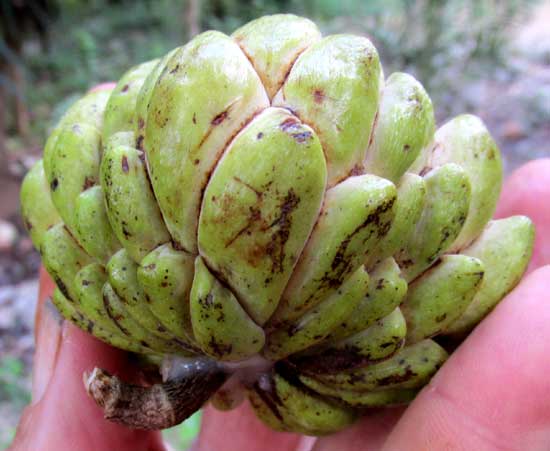
Below, you can see what that fruit looked like when it was broken open:
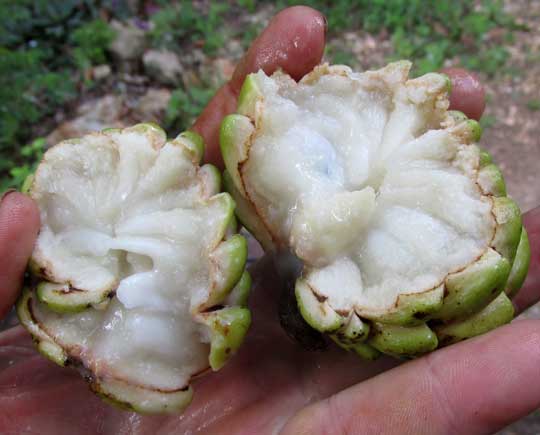
The flesh's texture is custard-like and sweet, and can be spooned from the fruit's green, bowl-like covering, which doesn't come apart at this stage. The flesh is full of big seeds, however, so eating these requires a lot of spitting. The flavor is so good that I'm surprised that often you see the fruits drying up and falling uneaten from people's trees.
from the August 18, 2008 Newsletter issued from Sabacché, Yucatán, MÉXICO
SWEETSOP/ SUGAR-APPLE/ SARAMUYO
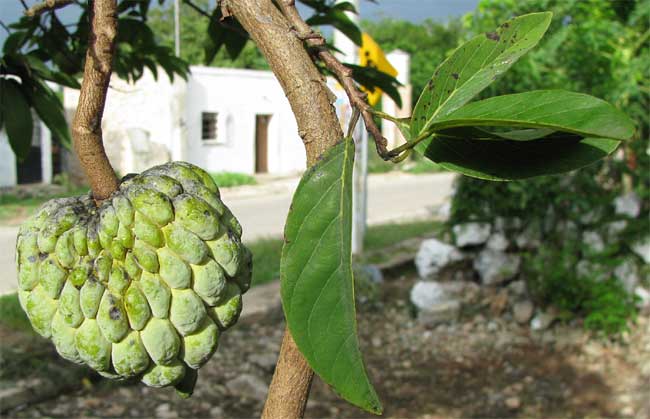
If you were with me in Chiapas you may recall the sweet Anona fruit, sometimes called Cherimoya in English, I enjoyed so much. Beside my front door here an Anona tree stands heavy with delicious fruits, but this Anona isn't the same species I introduced you to in Chiapas. The Chiapas Anona is shown here.
A fruit from the tree outside my door here is shown above.
Our Chiapas Anona was Annona cherimola, but the one outside my door is ANNONA SQUAMOSA, in English sometimes referred to as Sweetsop or Sugar-Apple. The most obvious difference between the fruits is that the Chiapas fruits' bumps aren't as distinct and well developed as those on the Yucatan fruits. In fact, when one of the fruits outside my door passes its peak of ripeness, turns brown and starts drying out, the bumps separate from one another and the fruit falls apart.
Anona fruits are "syncarps," which means that each fruit is derived from a single flower with two or more pistils, which partially fuse together as the pistils mature. Flowers containing several pistils traditionally have been regarded as being "primitive" -- as having evolved before flowers with only one pistil, which is the case with most flowers today.
People in Sabacché call the tree outside my door Saramullo and Tzermuy, and I wouldn't be surprised if in Mexico another 50 names could be found for it. Whatever it's called, the Annona squamosa outside my door bears fruits that are sweet and messy, and which gum up my beard so nicely that during a good eating session I draw honeybees.
from the May 21, 2017 Newsletter issued from Rancho Regensis north of Valladolid, Yucatán, MÉXICO;
elevation ~40m (~130 ft), N~20.876°, W~88.170°
SWEETSOP/ SARAMUYO FLOWERING
Until now we've only looked at the Sweetsop's fruits, but nowadays its branches bear flowers, one of which is shown below:
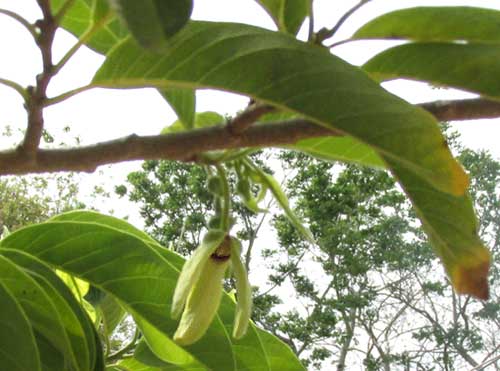
Below, a close-up shows the inch-long (2.5cm) flower's greenish-yellow petals:
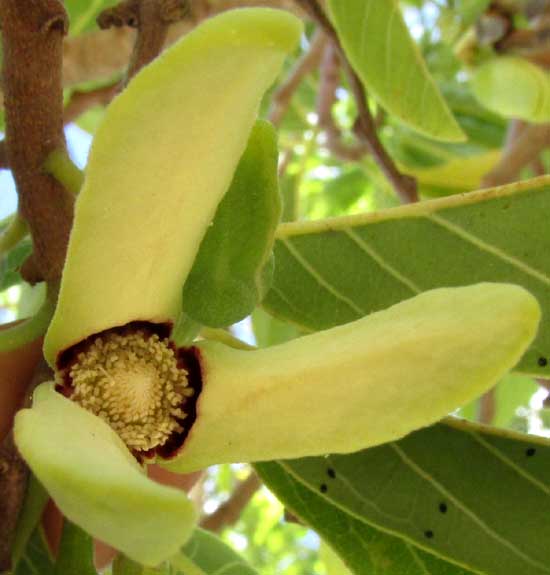
In that picture at first we notice only three petals, but if you look very close you can see that in the sinuses between the three yellowish petals, at the very bottom, there are tiny, flange-like projections. These are vestigial petals. The blossom's center is occupied by many yellowish, grainy objects, the larger on the area's periphery being pollen-producing stamens, while the more compact center is occupied with immature, hardly formed pistils consisting of stigma, style and ovary.
Four members of the genus Annona often are found planted here, and they can be confusing. You might like to review the four species. Besides the Sweetsop/Saramuyo considered here, there are:
The Cherimoya, Annona cherimola, often displaying small "finger-print depressions" over the fruit's surface, as shown on our Cherimoya page at www.backyardnature.net/chiapas/anona.htm
Soursop, or Guanábana, Annona muricata, whose large fruits bear numerous short, soft spines, as seen at www.backyardnature.net/yucatan/soursop.htm
The Custard-Apple or Bullocks-Heart, Annona reticulata, with smooth, heart-shaped or spherical fruits, profiled at www.backyardnature.net/yucatan/anona.htm